Podcast: Play in new window | Download
This week, I demonstrate the relative ease with which you can make this takeout staple for your own sweet self. Plus, absolutely no wok required! The shopping list might look a little daunting, but all the odd stuff will keep in your pantry a very long time, so whenever you have a pad thai craving, you just have to pick up the few fresh ingredients. The cucumber salad on the side is cool and refreshing, and just generally good to know.
Click to play this episode in a new window; right-click to download
Subscribe via iTunes
Subscribe via RSS
Shopping list
Rice noodles (whatever size you prefer)
Small shrimp
Firm tofu
Eggs
Rice vinegar
Fish sauce (aka nam pla or nuoc mam)
Tamarind concentrate (see photo below for options: Goya or other tropical brand unsweetened frozen pack; Thai unsweetened, stocked with other sauces; Mexican sweetened, stocked with drink mixes)
Sugar
Cayenne Pepper
Roasted, unsalted peanuts
Peanut oil (or vegetable oil)
Small dried shrimp (optional; see photo below)
Preserved radish (optional; see photo below)
Shallots
Garlic
Bean sprouts
Scallions
Cilantro
Limes
Cucumbers
Jalapeno or other small fresh chile, red or green
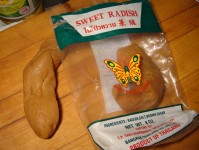
Preserved radish (click to enlarge)
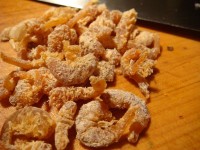
Dried shrimp (click to enlarge)
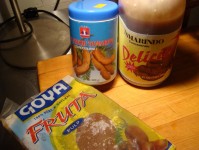
Varieties of tamarind concentrate: Goya frozen, Thai unsweetened, Mexican sweetened (click to enlarge)
Pad Thai
 The various ingredients are all worth tracking down for the extra flavor and texture they add, but the most important element is the tamarind, which adds the crucial sourness. Before you start, make sure you have your counters cleared and a lot of little bowls at the ready–you’ll want to keep each prepped element separate. Also, you can prep the various items in any order–the order I do it in the podcast is random, just as things popped to mind. You may devise a smarter system.
The various ingredients are all worth tracking down for the extra flavor and texture they add, but the most important element is the tamarind, which adds the crucial sourness. Before you start, make sure you have your counters cleared and a lot of little bowls at the ready–you’ll want to keep each prepped element separate. Also, you can prep the various items in any order–the order I do it in the podcast is random, just as things popped to mind. You may devise a smarter system.
For 2 dinner servings, and very generous lunch leftovers; could serve 3 hungry people for dinner, or even 4 not-so-hungry people
Set to soak in very hot tap water to cover:
8 oz. rice noodles
Peel the shells off:
5-6 oz. small shrimp (about 16)
Pat dry and chop into 1/2-inch-or-so cubes:
3-4 oz. firm tofu
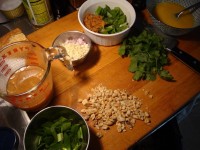 Set in separate bowls:
Set in separate bowls:
1-2 shallots, diced fine
2 garlic cloves, minced fine
2 eggs, lightly beaten
2 tsp water
Large pinch salt
Green parts of 2-3 scallions, sliced in 1/2-inch pieces (on a diagonal looks prettiest)
2-3 tbsp sweet preserved radish or turnip, in slivers (optional, but adds a nice chewy sweetness)
1/4 cup rice vinegar
1/4 cup fish sauce
Generous 1/4 cup tamarind concentrate (see shopping list for specifics; if using sweetened Mexican variety, omit sugar below)
Scant 1/4 cup sugar, or whatever to taste
Large pinch cayenne pepper, or whatever to taste
1-2 tbsp tiny dried shrimp, chopped coarsely (optional, but adds a nice extra layer of shrimpiness)
Large glug peanut or vegetable oil
*You may want to make a little extra of this sauce, in case your noodles get a little dry in the final cooking, or if you think you might be craving pad thai again within the week.
Garnishes, all in separate bowls:
2-3 cups bean sprouts, rinsed (these can just stay in your salad spinner to drain)
1/2 cup roasted, unsalted peanuts, coarsely chopped
Green parts from 1-2 scallions, sliced in 1/2-inch pieces
Leaves from half a bunch or so of cilantro
2 limes, quartered
*If you’ll be eating only part of the pad thai for dinner, and saving the rest, of course scale back the garnishes as necessary. If you have extras, store them separately from the pad thai so they stay fresh and crunchy.
When you’ve got everything prepped–or at least everything up to the garnishes–heat up a big cast-iron skillet on high. Add:
Big glug peanut oil (ideally; veg oil is fine too)
Toss in the tofu and fry, without stirring, until the tofu has a little crispiness on one side; stir to flip the cubes over and fry a bit longer. (This will take longer than you think, so you can use this time to prep the rest of your garnishes.) Then remove the tofu from the pan and set aside back in its bowl.
Add a little more oil to the pan if it’s looking dry, then toss in the shrimp and spread them out in a single layer. As soon as you can see pinkness creeping up the sides, flip them. By the time you’re done flipping them over, the first ones can come out–total cooking time is 1 minute, absolute max. Remove the shrimp from the pan and toss them in with the tofu.
Add a little more oil to the pan, then toss in the shallots and garlic. Fry until fragrant and just browning.
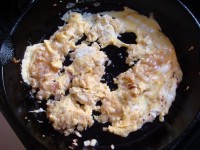 Then add the eggs, and stir a little and fry until set (as in photo), then break into chunks with your spoon.
Then add the eggs, and stir a little and fry until set (as in photo), then break into chunks with your spoon.
Drain the noodles, if you haven’t already, and add them to the pan and give them a quick stir. Then pour in the tamarind sauce mixture. There will be quite a lot of liquid. Turn the heat down to medium and let the noodles simmer for about 1 minute, just until the noodles have absorbed a lot, but not all, of the liquid–there should still be visible sauce in the bottom of the pan.
Toss in the scallions and the preserved radish. Stir to combine, and just let the scallions wilt (you might want to crank up the heat again very briefly). Finally, after about another 30 seconds, when the noodles are sticky but not dripping in sauce, turn off the heat, but leave the pan on the burner as you stir in the shrimp and tofu. (If in doubt, turn off the heat early–you don’t want your noodles to dry out and glom together.)
Let everything sit in the pan for a minute, for the flavors to meld, then serve up on plates, topped with bean sprouts, cilantro, peanuts, and fresh squeezes of lime.
Cucumber Salad
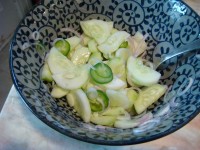 This cool, crunchy salad is a nice counterpoint to pad thai. It also goes well with just about any Asian-style stir fry. You can use any combination of shallot and/or scallion, or even red onion, and whatever kind of chili you have around. And, though, I don’t do it in the podcast because it would be too repetitious with the pad thai, you can also add cilantro.
This cool, crunchy salad is a nice counterpoint to pad thai. It also goes well with just about any Asian-style stir fry. You can use any combination of shallot and/or scallion, or even red onion, and whatever kind of chili you have around. And, though, I don’t do it in the podcast because it would be too repetitious with the pad thai, you can also add cilantro.
Serves 2
2 small cucumbers, or most of a large one
1 large shallot, or the white parts of 2 scallions
1/2 jalapeno, or green or red bird’s-eye chili
3-4 tbsp rice vinegar
1-2 tsp water
1-2 tsp sugar
Pinch salt
Peel the cucumbers and slice lengthwise, then into half-rounds, as thin as you have patience for. Slice the shallot in thin half-rings, or the scallions in rings. Slice the jalapeno in rings, discarding the seeds if you like. Combine all this in a bowl, then add the vinegar, water, sugar and salt and stir to combine. Let sit about 20 minutes if you have the time.
 Pad Thai
Pad Thai

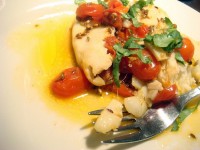
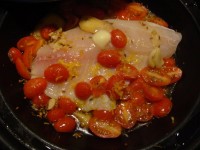
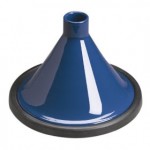

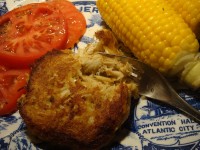
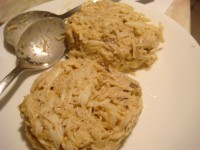

 Crab Cake
Crab Cake







